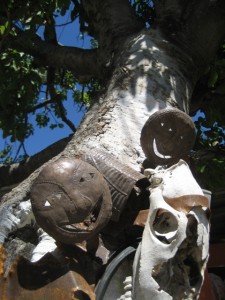![2691[1]](https://blog.itscactus.com/wp-content/uploads/2012/12/269112.jpg)
One of our many “Voodoo Inspired” pieces, this by Jean Eddy Remy
There is a saying that Haiti is 70 per cent Catholic, 30 per cent Protestant, and 100 per cent Voodoo. That may be a stretch of mathematical logic but it illustrates the point that the vast majority of Haitians – regardless of religious affiliation – hold at least some Voodoo beliefs. This varies with the individual, of course, from those holding nominal superstitions and belief in old wives’ tales with Voodoo roots, to full-scale worship and practice by priests and priestesses.
But what IS Voodoo, exactly? It has been defined as, “…a patchwork of beliefs based on animism and spirit worship brought from the African continent by plantation slaves more than two centuries ago. Voodoo is loosely structured and functions along oral traditions and improvisation, rather than by a prescribed set of norms and values.” This description, however, smacks of being shallow and rather discounts Voodoo as an actual religion. The fact that Voodoo has no formally written history, code of ethics and rules of practice – such as the Bible, the Torah, or the Koran – should not lead one to the conclusion that it is entirely random and therefore invalid. It does, however make it trickier to convey, though I am about try.
Caution thrown aside then, the best place for me to start is with God, who in Voodoo is referred to as “Bondye” or “Papa Bon Dye” meaning “Good God.” He is not unlike the God of Judeo-Christian tradition in that he is the Creator and he is One. Loa are spirits, which interact with the living. There are all kinds of Loa, representing good, evil, health, well-being, and virtually every aspect of life and living including that in the animal kingdom. During

Village “Voodoo Tree.”
the colonial era, French Catholics forbade native African religious practices so slaves secretly syncretized their Loa with Catholic saints to continue their traditional worship. Thus, virtually all Loa have saint associations, examples being Damballa with St. Patrick, Erzulie with the Virgin Mary, the Marassa Twins with Sts. Cosmas and Damien, and so on. The Loa are invoked in ceremonies and invited with drums, dancing and singing. During the ceremony, one or more Loa may be called upon to temporarily inhabit the physical bodies of the participants. Therefore, when one observes a representation of man with a fish body and bird wings, it is the representation of Loa inhabitation of the body.
Within Voodoo, there are two types, Rada and Petro. Rada is the Voodoo of health, happiness and peace while Petro, which gets all the hype, is the black magic Voodoo of death curses and zombies. By scholarly estimates, 95 percent of all voodoo practiced is of the Rada type. Curiously, there is no actual “Devil” in Voodoo, though aggression and anger are represented in both Rada and Petro by what most of us would recognize as a devil form.
With all of that in mind, have a look at our new “Voodoo Inspired” section. Get a feel for the blending of spirits and the life forces that Voodoo conjures. Sense the creative minds that imagine each piece. You don’t have to change your world view, just take a peek from a different perspective. You might be amazed.
First in a series regarding Haitian Voodoo
Contributed by Linda for It’s Cactus/Beyond Borders
